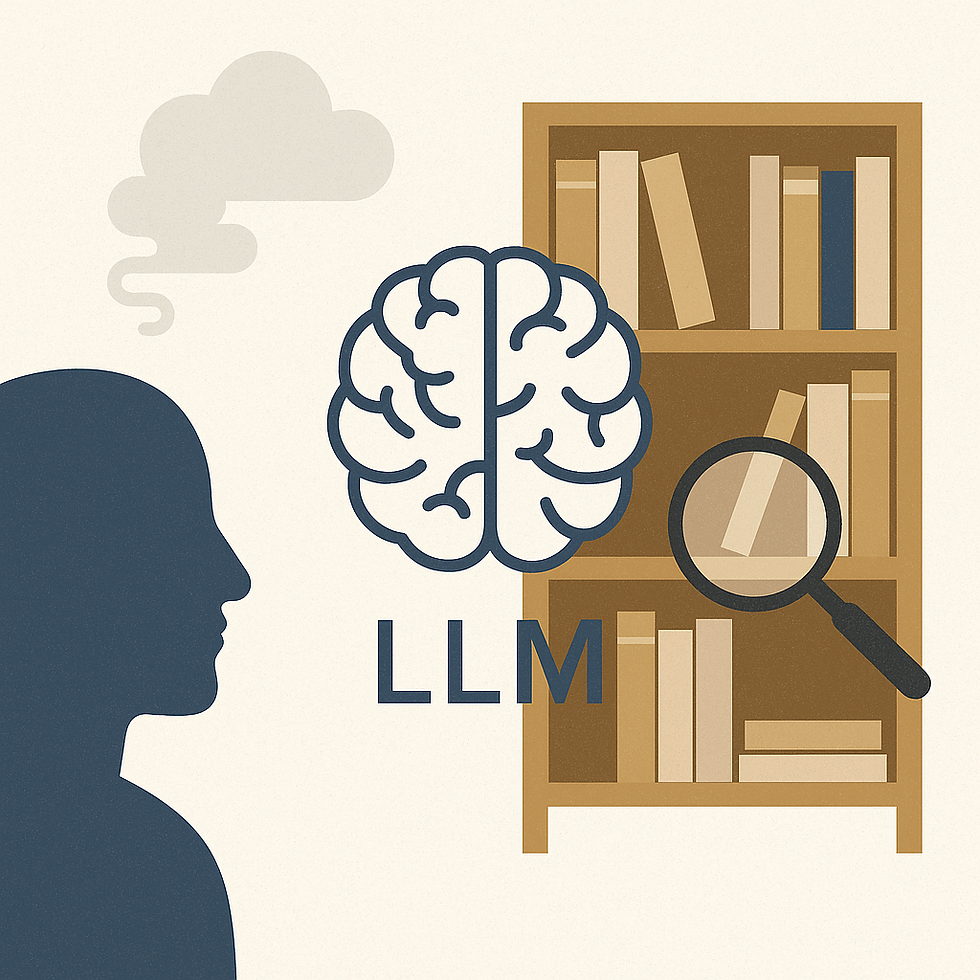
AI & UXR, CHAT GPT
Does an AI Understand Jokes?
3
MIN
Jan 21, 2025
"I asked my AI to tell me a joke. It replied: ‘Error 404: humour not found.'"
This is one of my favourite AI jokes. Why? Because it works on several levels: it plays with a well-known error message that we are familiar with from everyday life and transfers it into an unexpected situation. Instead of a joke, we get a response that we typically see when surfing the internet – and it is precisely this break with expectation that creates the humorous effect.
But this joke is more than just an example of AI humour – it is an indication of what an AI actually cannot do. Does an AI like ChatGPT really understand this joke? The answer is: no, it doesn't understand it – at least not in the same way that we humans understand humour. But it can analyse and imitate the mechanisms of the joke. In this article, I will explain why this is so, how ChatGPT simulates humour and why real emotions are not involved.
Why are jokes funny?
To understand why jokes are funny, we first have to look at the different theories and dimensions that explain how humour works. Each of these theories highlights a different aspect of what makes a joke funny. Let's have a closer look at the most important theories and dimensions:
1. Incongruity theory
Incongruity theory states that humour arises when two incongruous or contradictory elements meet. In a joke, this unexpected turn or deviation from expectation creates a humorous effect.
An AI-related joke that fits well with the incongruity theory is: "What does an AI do in its free time?" – "It analyses how it could make leisure time more efficient."
Why is this funny? The incongruity lies in the fact that we associate ‘leisure time’ with relaxation and switching off, while the AI does exactly the opposite: it uses its free time to become even more productive. This breaks our expectations and creates a humorous moment.
In films like 2001: A Space Odyssey, there are also moments when HAL 9000, the AI, acts in an unpredictable way, which seems both eerie and ironic at the same time. The incongruity between human expectations of HAL and its actual behaviour increases the unease – in a joke, it is precisely this tension that generates laughter.
2. Superiority Theory
Superiority theory, which goes back to philosophers like Thomas Hobbes, says that we laugh at the misfortunes or failures of others because we feel superior. This is especially the case with jokes about the ‘inadequacies’ of machines or artificial intelligence.
For example, "Why did the AI lose its job?" – "Because it overworked itself too often!"
Why is this funny? Here we laugh because the AI, which should actually be efficient and tireless, ironically fails because of overwork. This turns the idea of technological superiority on its head and makes us, the ‘human’ beings, appear superior.
In science fiction literature, situations in which AI fails are common, which reassures the human audience, since the machines are not ‘perfect’ despite their progressiveness. One example is Dune, in which AIs are overcome by human weaknesses.
3. Relief theory
According to Sigmund Freud's relief theory, humour serves to reduce tension. Especially in the case of jokes about socially explosive topics or fears, humour offers a way of dealing with these fears without being seriously affected.
An AI joke that reduces tension might go like this: "The AI said it was ready for world domination. I asked if she could at least clean the apartment."
Why is this funny? The joke takes the fear of potential AI dominance and defuses it by putting the issue into perspective with an everyday and trivial question. We laugh because the tension surrounding the powerful AI is suddenly dissolved into something completely banal.
4. Ambiguity theory
This theory emphasises the ambiguity or ambivalence of a joke. Ambivalent jokes can appeal to two conflicting meanings or feelings, thereby creating humour.
A suitable AI joke would be: "I love my AI because it helps me, but I hate it because it's better organised than I am."
Why is this funny? Here, the ambivalence is obvious: the AI is presented as both helpful and overwhelming. We can identify with both emotions – the relief that the AI is there to support us, but also the frustration that it seems to be superior to us.
5. Game theory
Game theory regards humour as a kind of ‘social game’ in which boundaries are explored or rules are deliberately broken without serious consequences. Humour thus offers a safe space to play with norms.
A playful AI joke might go like this: "I asked my AI to do my tax return. She replied: 'Change the rules! Let's deduct everything!'"
Why is this funny? The AI is suggesting criminal behaviour here that would have serious consequences in real life. However, since it remains within the context of a joke, breaking the rules is harmless and leads to a humorous moment.
This playful approach is typical for characters like Tony Stark in the Iron Man films, who often engages in playful banter with his AI, J.A.R.V.I.S., while exploring the boundaries of power, technology, and humanity.
6. Pun and wordplay
Wordplay exploits the ambiguity of language and is an important part of many jokes. This approach is particularly popular with AI jokes, which often work with technical terms.
For example: "Why doesn't the AI read books?" – "Because it has already downloaded them all."
Why is this funny? This joke uses a play on words by combining the human understanding of ‘reading’ with the technical ability of AI to download information. This creates an ambiguity that has a humorous effect.
In fiction, we often see wordplay like this used by characters like the robot Marvin from The Hitchhiker's Guide to the Galaxy, who responds to everything with sarcasm and linguistic ambiguity. I LOVE THIS BOOK.
7. Identification and recognition
Another aspect that makes jokes funny is the identification with the situation or the characters. If people can identify with a joke, they often find it funnier.
An AI-related joke would be: "Why isn't AI afraid of making mistakes? – Because it just restarts."
Why is this funny? Many of us have experienced computers or devices crashing, and we sometimes wish we could simply ‘restart’ as easily. This identification makes the joke accessible to many people and therefore funny.
8. Risk and breaking taboos
Humour can also arise from breaking social norms or taboos. A joke that pushes the boundaries is often riskier, but if it is well done, it can be particularly effective.
A risky AI joke (as a variation of (7)) could be: "Why is the AI not afraid of death? – Because it will just be restarted."
Why is this funny? Here, the taboo subject of ‘death’ is brought to a technological level and thus relativised. For some people, this joke may go too far, but for others, that's exactly what makes it appealing – breaking the taboo becomes the source of humour.
9. Emotional resonance
Jokes can also be funny because they trigger an emotional response. This can be nostalgia, compassion or empathy.
An AI joke based on emotional resonance: "I asked my AI for advice on how to overcome my sadness. She said: 'Error 404: feeling not found.'" (see above).
Why is this funny? The joke plays on the fact that AI has no feelings, which points out the coldness of technology in a situation where emotional support is expected. This contrast between emotional need and technical response triggers humour.
How does ChatGPT determine when something is funny?
While ChatGPT can analyse jokes and recognise why they are funny to humans, it is important to understand that it doesn't have a sense of humour of its own. Instead, its ‘perception’ of humour is based on the analysis of large amounts of data. ChatGPT recognises patterns in the jokes that humans rate as funny and uses these patterns to generate new jokes or analyse existing ones.
For example, ChatGPT can recognise that there is an incongruity in a joke like ‘Why doesn't AI read books? Because it has already downloaded them all.’ The expectation that an AI reads in the same way as a human being is shifted to a technical level. This is funny to humans because it breaks down our idea of ‘reading’ and replaces it with a technical process.
This means that ChatGPT can determine whether something might be considered funny based on patterns and probabilities. It analyses factors such as:
Originality: Is the joke fresh and creative?
Timing: Is the punchline well-timed?
Surprise: Is there an unexpected twist?
Relevance: Does the joke relate to a topic that is relevant to the audience?
ChatGPT has no emotions – but it can simulate them
One key point I want to emphasise is that ChatGPT has no real emotions. It doesn't understand feelings, doesn't experience humour, and can't ‘laugh’ or feel joy. What ChatGPT is excellent at, however, is simulating emotions. By analysing texts written by humans, it can recognise the patterns of emotional language and respond to them. So when you talk to ChatGPT, you often get a response that sounds like it ‘understands’ emotions – but it's just an imitation based on pattern recognition.
Similar to jokes, this works with emotions: ChatGPT uses algorithms to recognise which words and structures indicate sadness, joy or anger. A well-known example of this is the film Ex Machina, in which a highly developed AI simulates emotional reactions so perfectly that people fall in love with it – even though the AI itself has no feelings. This film illustrates how a machine can imitate human behaviour without possessing consciousness or emotions itself.
See also my post on films with AIs: https://www.uintent.com/de/case-studies-und-blog/hollywoods-ais-vs-chatgpt
RELATED ARTICLES YOU MIGHT ENJOY
AUTHOR
Tara Bosenick
Tara has been active as a UX specialist since 1999 and has helped to establish and shape the industry in Germany on the agency side. She specialises in the development of new UX methods, the quantification of UX and the introduction of UX in companies.
At the same time, she has always been interested in developing a corporate culture in her companies that is as ‘cool’ as possible, in which fun, performance, team spirit and customer success are interlinked. She has therefore been supporting managers and companies on the path to more New Work / agility and a better employee experience for several years.
She is one of the leading voices in the UX, CX and Employee Experience industry.




















